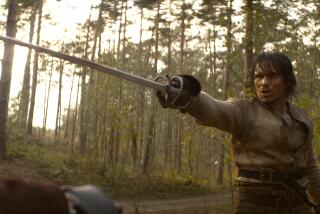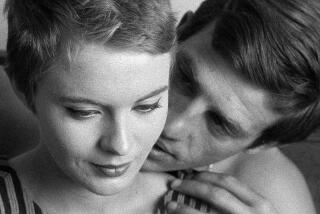FILM : Simple Tension Earns Great ‘Wages of Fear’
- Share via
Director Henri-Georges Clouzot’s accomplishment in “Wages of Fear” is remarkable, especially when compared to the technology-dominated, big-money thrillers of today. He turned a bumpy truck ride into an adventure with existential overtones.
The 1953 movie, screening at the Wilshire Auditorium on Friday night, is a masterpiece of its kind. Sometimes described as France’s answer to Alfred Hitchcock, Clouzot shows a link to Hitchcock by letting tension build from a simple conflict: An oil fire is burning at a distant South American refinery, and four desperate tramps are hired to help put it out. They must drive 300 miles of mean highway to deliver a ton of nitroglycerin, knowing that any pothole could detonate the cargo.
The genius here is in the mundaneness of their obstacles. During the adventure, based on Georges Arnaud’s novel, Clouzot and co-writer Jerome Geronimi avoid sensational confrontations; there are no bandits, saboteurs or hell-sent storms standing in the way. The three barriers--a rickety bridge landing, a medium-sized boulder and a waist-deep pool of oil--test the men’s ingenuity and courage.
Clouzot’s deftness is in linking us to the events at hand. Besides the realistic challenges, which allow the audience to identify with what they’re doing, he takes almost half of the film to develop our relationship with the four characters, especially Yves Montand’s Mario and Charles Vanel’s Jo.
“Wages of Fear” (remade unsuccessfully as “The Sorcerer” in 1977 by William Friedkin) is really divided into two distinct parts. The thrill comes later, when the nitro is hauled. First, though, we are presented with a more subdued, almost brooding “art film” look at life in the dusty, sun-bleached town of Los Piedras.
Mario, like the rest of the discards that have blown into Los Piedras, waits for something to happen. There isn’t any work, so he drinks, naps and flirts with Linda (Vera Clouzot, the director’s wife), a pretty barmaid. Montand is as laconic as ever, but he infects Mario with a touch of self-doubt as well; it’s a little surprising when this loner rises above himself on the trek.
Jo appears on the scene and takes over the town--the flinty-eyed Vanel plays him like a Mafia boss, dominating everybody with his bullying swagger. His true character is also revealed later. The other two, the resourceful Bimba (Peter van Eyck) and playful fool Luigi (Folco Lulli), are also Los Piedras fixtures, looking for a change.
In this sense, the town is like a purgatory. The opening close-up of a boy spiking cockroaches in the dirt sets a tone of casualness about life. Nothing seems to have value or consequence; everybody sleepwalks. The men are attracted not only by the $2,000 they’ll be paid for the trip, but also by the opportunity to overcome their environment.
“Wages of Fear” benefits from expert editing (Henri Rust, Madeline Gug and E. Muse), which cuts from tense close-ups to expansive sweeps of the forbidding landscape. Armand Thirard’s cinematography is revelatory, whether in the town or on the highway. The shadows in the bar seem to cage the men as they sip their drinks; on the road, the camera jumps to Luigi’s face, showing his suppressed terror as they prepare to blow up the boulder.
The last scene is simply beautiful movie making. The dingy bar is illuminated by sunlight as a waltz plays from the radio and everybody dances, momentarily forgetting their poverty. Mario, in his truck returning home, hears the same song and turns the wheel foolishly back and forth, doing his own driving dance.
What: Henri-Georges Clouzot’s “Wages of Fear.”
When: Friday, 7:30 p.m.
Where: The Wilshire Auditorium, 330 N. Lemon St., Fullerton.
Whereabouts: Take the Riverside Freeway to Lemon Street and head north.
Wherewithal: $4 and $5.
Where to Call: (714) 871-4030, Ext. 15.
More to Read
Only good movies
Get the Indie Focus newsletter, Mark Olsen's weekly guide to the world of cinema.
You may occasionally receive promotional content from the Los Angeles Times.










